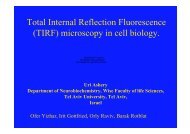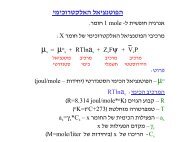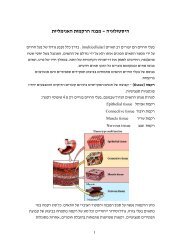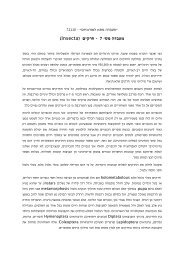Embden-Meyerhof-Parnas Pathway - TeachLine
Embden-Meyerhof-Parnas Pathway - TeachLine
Embden-Meyerhof-Parnas Pathway - TeachLine
You also want an ePaper? Increase the reach of your titles
YUMPU automatically turns print PDFs into web optimized ePapers that Google loves.
<strong>Embden</strong>-<strong>Meyerhof</strong>-<strong>Parnas</strong><br />
<strong>Pathway</strong><br />
a.k.a Glycolysis<br />
Stryer’s 6 th edition, chapter 16 <br />
1
and many more… <br />
2
Hans & Eduard Buchner<br />
• Yeast extract can<br />
ferment sugar to<br />
alcohol. <br />
• Refutation of the<br />
vitalistic dogma<br />
(Pasteur). <br />
• Things can happen<br />
outside of cells. <br />
• Nobel prize medicine<br />
1907. 5
Why glucose?<br />
• Is formed in prebiotic conditions from<br />
formaldehyde. <br />
• Glucose has a low tendency to glycosylate<br />
proteins since the cyclic form is favored. <br />
7
Glucose phosphorylation<br />
• Traps glucose in the cell <br />
• Destabilizes glucose for future metabolism. <br />
10
Kinase <br />
The trick here is to add the phosphate<br />
to the substrate and not to water. <br />
The reason for the difficulty is that<br />
water is far more abundant. <br />
11
Phosphoglucose isomerase: Aldose ⇌ Ketose <br />
12
Bis means two separate groups <br />
while di means two connected groups (e.g. ADP) <br />
13
The name of the enzyme comes from<br />
The reverse reaction: aldol condensation <br />
15
The aldose to ketose conversion <br />
• Without step II, the aldose cleavage would<br />
have resulted in two fragments: <br />
– 2 carbon unit <br />
– 4 carbon unit <br />
• This would have required two separate<br />
pathways. <br />
18
Rate enhancements of 1010. <br />
Diffusion limited <br />
19 <br />
The reaction is unfavored, but is driven by subsequent steps.
Decomposition is favored 100 to 1. <br />
20
Acyl phosphate: <br />
a mixed anhydride with high phosphoryl transfer potential <br />
22
ΔG= -50kJ mol-1 <br />
ΔG= 50kJ mol-1 <br />
24
Coupling makes sure that this can work. <br />
25
Hydride transfer <br />
The + <br />
charge helps <br />
26
Substrate level phosphorylation <br />
27
G3P dehydrogenase + PGK <br />
• G3P an Aldehyde is oxidized to carboxylic<br />
acid. <br />
• NAD + is reduced to NADH. <br />
• ATP is formed from Pi at the expense of<br />
carbon-oxidation energy. <br />
28
The final 3 steps <br />
• A rearrangement of (3-phosphoglycerate)<br />
3PG to 2PG (2-phosphoglycerate). <br />
• Dehydration of 2PG to an enol <br />
29
Phosphoglycerate mutase<br />
• The enzyme requires a catalytic amount of 2,3-<br />
BPG. <br />
• This maintains an active site His in a<br />
phosphorylated form.<br />
Enz-His-phosphate + 3PG ⇌<br />
Enz-His-phosphate + 2,3-BPG <br />
• Then the enzyme acts as a phosphatase:<br />
Enz-His-phosphate + 2,3-BPG ⇌<br />
Enz-His-phosphate + 2BPG <br />
31
Enolase<br />
• This step is critical in elevating the transfer<br />
energy of the enol phosphate: <br />
– A regular ester phosphate hydrolysis is -13 kJ<br />
mol-1 <br />
– An enol phosphate hydrolysis is -62 kJ mol-1 <br />
• This enables the next step which is another<br />
substrate level phosphorylation. <br />
32
The instability of<br />
phosphoenolpyruvate (PEP)<br />
• The phosphate in (PEP) traps the molecule<br />
in the unstable enol form. <br />
• Upon hydrolysis the enol can be converted<br />
to the much more stable ester. <br />
33
The outcome<br />
• Two ATP molecules invested <br />
• Four ATP molecules gained <br />
• Net is two ATPs per glucose and two<br />
NADHs:<br />
Glucose + 2Pi + 2ADP + 2NAD + <br />
2pyruvate + 2ATP + 2NADH + 2H + +2H 2 O <br />
36
What to do with the NADH?<br />
• The redox balance hasn’t been maintained<br />
due to the formation of NADH (activity of<br />
GA3P dehydrogenase). <br />
• Since NAD + is limiting it must be<br />
regenerated (comes from niacin a vitamin). <br />
• While glycolysis is constant, the fate of<br />
pyruvate isn’t. <br />
37
The active site of <br />
Alcohol dehydrogenase <br />
39
Alcoholic fermentation <br />
40
Fermentations <br />
• In the absence of oxygen the body can<br />
extract a small amount of energy out of<br />
glucose. <br />
• In bursts of activity the ability to supply<br />
oxygen is limited. <br />
• Some organisms cannot live in the presence<br />
of oxygen. <br />
45
The NAD + binding pocket is diverse dehydrogenases <br />
is very similar pointing to evolutionary relationship <br />
47
Usage of other <br />
sugars is via <br />
glycolysis as well <br />
48
Entry into<br />
glycolysis <br />
49
Net reaction:<br />
Galactose + ATP <br />
Glucose 1-phosphate<br />
+ ADP + H +<br />
51
Lactase deficiencies <br />
• During maturity lactase activity is down to<br />
5-10% relative to youth. <br />
• The undigested lactose is fermented by<br />
microorganisms in the gut to methane and<br />
H 2 with obvious side effects. <br />
• The lactic acid causes water absorption with<br />
additional consequences. <br />
53
Lactobacillus <br />
54
Galactosemia<br />
• Deficiency in transferase cause<br />
accumulation of galactose. <br />
• This results is severe pathologies, such as<br />
clouding of the eye due to the osmolitic<br />
behavior of galactitol.<br />
55
Glycolysis regulation <br />
• Glycolysis not only supplies energy but also<br />
metabolites, hence it must be tightly<br />
regulated. <br />
• The regulation occurs in the three<br />
irreversible steps in the pathway: <br />
– Phosphofructokinase <br />
– Hexokinase <br />
– Pyruvate kinase <br />
56
Phosphofructokinase<br />
• Activated by AMP (Le Chatelier). <br />
• Inhibited by ATP (Le Chatelier). <br />
• The ATP/AMP ratio reflects the energy<br />
state of the cell. <br />
• AMP is a better indicator than ADP due to<br />
the activity of adenylate kinase: <br />
• ADP + ADP ⇌ AMP + ATP <br />
• It is also inhibited by low pH that reflects<br />
lactic acid accumulation due to anaerobic<br />
respiration. <br />
57
Hexokinase<br />
• Hexokinase is inhibited by its product<br />
glucose 6-phospahte. <br />
• When PFK is inactive fructose 6-phosphate<br />
is accumulated.<br />
• In turn fructose 6-phosphate is converted<br />
into glucose 6-phospahte and inhibits<br />
Hexokinase. <br />
• This a communication between 2 enzymes <br />
60
PFK versus Hexokinase<br />
• PFK is the most important regulatory point. <br />
• The reason is that glucose 6-phospahte can<br />
be used to synthesize glycogen as well. <br />
• So the activity of PFK represents the 1 st<br />
committed step in the catabolic pathway of<br />
glycolysis.<br />
61
Pyruvate Kinase (PK)<br />
• Inhibited by ATP allosterically. <br />
• Alanine inhibits the enzyme as well to<br />
signal that there is enough building blocks. <br />
• Fructose 1,6-bisphosphate allosterically<br />
activates PK to make sure that it “keeps up”<br />
with the rest of the pathway. <br />
62
The liver <br />
• The liver is different from the rest of the<br />
body since it controls the blood glucose<br />
levels. <br />
• It can store glucose as glycogen and release<br />
glucose into the blood stream when<br />
[glucose] falls. <br />
• So it has additional interesting pathways<br />
and regulatory strategies. <br />
65
PFK in the liver<br />
• Not inhibited by lowering the pH since<br />
lactate doesn’t accumulate in the liver (it is<br />
converted back to glucose). <br />
• PFK is inhibited by citrate a key<br />
intermediate in the Krebs cycle thru<br />
enhancing the inhibitory effects of ATP. <br />
• High levels of citrate mean that there is<br />
plenty of metabolites. <br />
66
PFK and glucose in the liver<br />
• An increase in [glucose] results<br />
in an increase in [fructose 6P]. <br />
• This in turn results in an<br />
increase in [fructose-2,6-BP]. <br />
• F-2,6-BP increases the affinity<br />
of PFK to F-6P and diminishes<br />
the effect of ATP. <br />
• Thus glycolysis is accelerated<br />
when glucose is abundant.<br />
• This is called feed-forward<br />
stimulation <br />
67
Remember that ATP is both a substrate and an allosteric inhibitor! <br />
68
Liver Hexokinase<br />
• Most enzymes are highly tuned towards their substrates, having<br />
a very low K m . <br />
• Since often [S] > K m , a change in substrate concentration does<br />
not change the reaction rate appreciably. <br />
• Thus, controlling a metabolic flux is not normally achieved by<br />
varying substrate concentrations. <br />
• A notable exception is glucokinase (Hexokinase IV) in the liver<br />
which has a very high K m which is roughly comparable to blood<br />
glucose concentration. <br />
• This enzyme was thought to be the glucose sensor in the body.<br />
69
Pyruvate kinase in the liver<br />
• There are several PK isozymes. <br />
• L-PK isozyme behaves like M-PK except<br />
for the fact that it is inhibited by<br />
phsophorylation which is a result of<br />
glucagon stimulation (see later on). <br />
• This prevents the liver from consuming<br />
glucose when concentration of glucose is<br />
low and it is needed in the brain. <br />
70
Remember the blood [glucose] is 4-8 mM <br />
72
Glycolysis and cancer<br />
• Tumors develop faster<br />
than the ability of blood<br />
vessels to support them. <br />
• Hence they are in the state<br />
of hypoxia – oxygen<br />
deprivation. <br />
• So they rely on glycolysis<br />
for energy. <br />
• In hypoxia the<br />
transcription factor HIF-1<br />
induces many enzymes in<br />
glycolysis. <br />
73
Gluconeogenesis <br />
• Synthesis of glucose from non-carbohydrate sources. <br />
• Glucose in the primary energy source of the brain and the<br />
only one for red blood cells. <br />
• Daily glucose requirement of the body is 160gr, of which<br />
120gr is for the brain. <br />
• In the blood we have about 20gr and in glycogen another<br />
190gr. <br />
• So gluconeogenesis is needed at times of starvation. <br />
• Most gluconeogenesis takes place in the liver and a small<br />
amount in the kidney. <br />
75
Gluconeogenesis <br />
• Conversion of metabolites to pyruvate and then to<br />
glucose. <br />
• Other metabolites may enter at a later stages. <br />
• The major inputs are:<br />
– lactate from glycolysis (lactate dehydrogenase) <br />
– Amino acid from protein breakdown during starvation. <br />
– Glycerol from lipid breakdown (see later). <br />
• Note that fat cannot be used to make glucose in<br />
mammals. <br />
76
Gluconeogenesis is not <br />
The reverse of glycolysis. <br />
(unique reactions are shown <br />
in red). <br />
The reason is the the ΔG of <br />
Glycolysis is -84 kJ/mol so <br />
it is essentially irreversible. <br />
78
The “essentially” irreversible steps are in red again <br />
79
Steps 1 and 3: “simple”<br />
hydrolysis by phosphatases <br />
80
Note that 5 proteins are required to <br />
Make glucose form G6-P <br />
81
Step 10: Forming PEP from pyruvate in 2 steps<br />
The first step takes place in the mitochondria by<br />
pyruvate carboxylase, a biotin dependent enzyme<br />
82
Pyruvate carboxylase<br />
83
We will cover the<br />
malate-aspartate<br />
shuttle later in the<br />
course <br />
85
The second step takes place in the cytoplasm<br />
by phosphoenolpyruvate carboxykinase<br />
Note that the CO 2 is now taken off.<br />
Why was it added in the first place?<br />
The decarboxylation drives the reaction. <br />
86
The cost of gluconeogenesis <br />
• 6 molecules of ATP are needed to make<br />
glucose from pyruvate <br />
• Versus only 2 that you get from glycolysis. <br />
87
Reciprocal regulation <br />
88
Glycolysis versus<br />
gluconeogenesis in the liver <br />
• F 2,6-BP stimulates PFK and inhibits F 1,6<br />
bisphosphatase. <br />
• When [glucose] is low F 2,6-BP loses a<br />
phosphate to form F 6P which no longer<br />
binds to PFK. <br />
• 2 enzymes control this reaction: <br />
– One that phosphorylates F 6P <br />
– One that hydrolyses F 2,6-BP <br />
89
They are both on the same gene! <br />
Phosphofructokinase 2 + fructose bisphosphatase 2 <br />
Phosphorylation of a single Ser when [glucose] is scarce <br />
Activates the phosphatase and inhibited the kinase. <br />
90
Stimulation via gene expression <br />
Of insulin response elements and<br />
glucagon response elements <br />
92
Substrate cycles for<br />
heat and regulation <br />
Discussed<br />
previously <br />
93
The Cori cycle <br />
94
Evolution<br />
• Glycolysis and gluconeogenesis deal with 6<br />
and 3 carbon sugars. <br />
• The enzymes that deal with trioses are very<br />
conserved and seem to have arisen very<br />
early in evolution. <br />
• It can be used to generate riboses as well. <br />
• So was the origin catabolic or anabolic? <br />
96
















